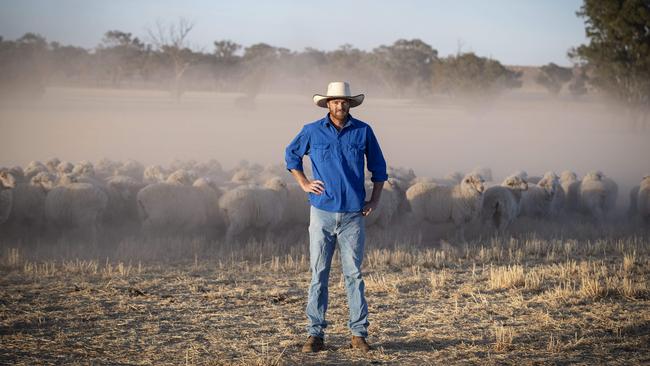Science helps farmer Nick Kershaw move with the changing climate
Nick Kershaw can feel the climate changing and see the impact on his land, so to keep farming he’s using all science has to offer.

Nick Kershaw can feel the climate changing and see the impact on his land, so to keep farming he’s using all science has to offer to adapt.
Mr Kershaw and his father, Rod, run a 1250ha mixed farming property near Greenethorpe in NSW’s central west, growing wheat, canola and chickpeas and running merino sheep.
There is, he says, anecdotal evidence it’s getting hotter and drier.
“I can remember as a kid you’d never have that many days over 40C,” Mr Kershaw said.
“Now we have regular heat waves that go on for days.”
There’s also accurate evidence pointing to reduced rainfall: the CSIRO uses 8ha of the Kershaw property as a research station to conduct a variety of agricultural experiments, and it includes a weather station.
Over the past century, Mr Kershaw said, annual rainfall averaged 600mm, but in the past 30 years it measured 500mm.
The pattern of rainfall over the year has changed, too: Mr Kershaw said the solid winter rains that used to come “like clockwork” now sometimes come and sometimes don’t, while big summer thunderstorms blast down more rain than they used to.
With the help of new, specially designed crop varieties, including a canola developed by the CSIRO, and different farming techniques, the Kershaws are moving with the changing climate, developing drought resistance.
Rather than traditional wheat and canola grown purely for their grain and seeds, the Kershaws plant what’s known as “dual purpose” varieties that can serve both as fodder for their sheep and a cash crop.
Planted in autumn, Kittyhawk wheat and the CSIRO canola can be grazed for two or three months in winter, providing nutrition for the sheep and allowing the Kershaws to spell their paddocks of improved pasture.
The sheep then get taken out of the crops and put back on the pasture in late winter or early spring, and because the wheat and canola are designed to flower late, they still produce a commercial crop for harvest.
The drought has been severe on the Kershaw property; over the growing season from April to October, the average rainfall is 300mm, but in the season just gone only 120mm fell.
Most farmers relying only on pastures have had to drastically de-stock. With the dual purpose wheat and canola, the Kershaws have only reduced their flock from 2500 breeding ewes in a good year down to 2000, and those seen by The Australian looked in good shape with big fleeces.
“We have been able to hang on to most of our stock,” Mr Kershaw said. “If you were just a straight grazier and you don’t crop, it would be tough.”
CSIRO research led by scientist John Kirkegaard found sheep farmers who plant the dual purpose canola gain an average of $400 a hectare through savings on additional feed and improved livestock condition.
Mr Kershaw plans to introduce other leading-edge practices to develop drought resilience on his property, including what are known as summer cover crops.
Bare earth during a drought will retain only some moisture from thunderstorms, but if in early summer, after the winter crop is harvested, a farmer plants millet or sorghum, it will help gain maximum benefit from any rain.
“With that, you can catch your rain, and you can keep your soil cooler,” Mr Kershaw said.




To join the conversation, please log in. Don't have an account? Register
Join the conversation, you are commenting as Logout